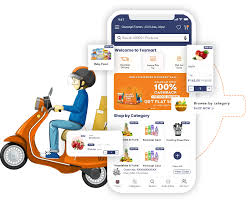In a world where time is a luxury, grocery delivery apps have reshaped consumer behavior by making daily shopping effortless and instant. The online grocery market is booming, driven by convenience, user-centric design, and powerful backend solutions. As more retailers go digital and entrepreneurs eye this growing space, grocery delivery app development becomes a key focus in 2025.
In this article, we’ll explore everything you need to know to build a successful grocery delivery app—from market trends and must-have features to tech stacks and cost estimation. Whether you’re a startup, a retailer, or an enterprise, this guide will help you understand the ins and outs of building a winning grocery delivery solution.
📈 The Rise of Grocery Delivery Apps
According to recent reports, the global online grocery market is projected to reach $1.3 trillion by 2030. Several factors contribute to this surge:
-
Increased smartphone usage
-
Changing shopping habits post-COVID
-
Time-saving convenience
-
Integration of AI for personalized shopping
Grocery delivery apps like Instacart, BigBasket, and Amazon Fresh have already captured a significant market. However, with niche needs and hyperlocal delivery growing in demand, there’s plenty of space for innovation.
🧠 Understanding the Business Models
Before you begin grocery delivery app development, it’s essential to decide on the right business model:
1. Inventory Model
The app owner manages their own inventory and fulfills orders. Ideal for grocery chains.
2. Marketplace Model
You list multiple grocery vendors on the app and earn through commission or subscription. Popular among startups.
3. Hyperlocal Delivery Model
This connects local stores to nearby customers, focusing on real-time delivery. Great for city-specific markets.
Each model has its pros and cons, and your choice should align with your budget, resources, and long-term vision.
🔍 Key Features Your Grocery App Must Have
To compete in the ever-growing grocery delivery space, your app should be equipped with essential features for all stakeholders—users, delivery agents, and administrators.
For Customers:
-
User Registration/Login (via phone, email, or social media)
-
Smart Search & Product Categorization
-
Real-Time Order Tracking
-
Multiple Payment Options (credit/debit cards, wallets, UPI)
-
Wishlist & Repeat Orders
-
Delivery Scheduling
-
Push Notifications for Offers
-
Rating & Review System
For Delivery Agents:
-
Profile Management
-
Order Acceptance & Rejection
-
GPS-Based Route Optimization
-
In-App Chat with Customers
-
Earning Dashboard
Admin Panel:
-
User & Vendor Management
-
Inventory Control
-
Order Management Panel
-
Delivery Tracking Dashboard
-
Offer/Coupon Management
-
Reports & Analytics
🚀 Advanced Features to Stay Ahead in 2025
Want your app to stand out? Integrate these trending features:
-
Voice Search: Let users find products faster using voice commands.
-
AI-Based Recommendations: Suggest items based on browsing and purchase history.
-
Subscription Models: Weekly or monthly grocery delivery at a fixed price.
-
AR for Product Viewing: Augmented reality to preview products before buying.
-
Carbon Footprint Calculator: Appeal to eco-conscious users.
🔧 Tech Stack for Grocery Delivery App Development
Your choice of technology will define the performance, scalability, and user experience of your grocery app.
Frontend:
-
React Native or Flutter (for cross-platform mobile apps)
-
React.js or Angular (for web apps)
Backend:
-
Node.js, Python (Django), or PHP (Laravel)
-
Firebase for real-time database support
Database:
-
PostgreSQL, MongoDB, MySQL
Cloud & Hosting:
-
AWS, Google Cloud, Microsoft Azure
APIs:
-
Twilio (SMS & call verification)
-
Stripe, PayPal, Razorpay (payment gateways)
-
Google Maps API (location tracking)
Make sure to also include robust cybersecurity protocols, data encryption, and GDPR compliance if operating in Europe.
💸 Cost to Develop a Grocery Delivery App
The cost of grocery delivery app development varies based on features, platform (iOS, Android, or both), and development region.
Here’s a rough estimate:
| Development Area | Estimated Cost Range |
|---|---|
| Basic MVP App | $10,000 – $20,000 |
| Mid-Level App with Features | $25,000 – $50,000 |
| Advanced App with AI/AR | $60,000 – $100,000+ |
Outsourcing to countries like India can lower development costs significantly while still maintaining quality.
🛠 Development Stages: Step-by-Step Process
1. Market Research & Planning
-
Identify your target audience
-
Analyze competitors
-
Define USPs (Unique Selling Propositions)
2. UI/UX Design
-
Wireframes & Prototypes
-
Design user-friendly and attractive interfaces
3. Development
-
Frontend and backend coding
-
Integration of APIs and databases
4. Testing
-
Manual & automated testing for bugs, glitches, and performance
5. Launch
-
App store submission
-
Website deployment
-
Marketing & onboarding
6. Post-Launch Support
-
Regular updates
-
Customer support system
-
Feature enhancements based on user feedback
📊 Monetization Strategies for Grocery Apps
Here are proven ways to make money from your grocery delivery app:
-
Delivery Charges: Add a service fee per order.
-
Commission from Vendors: Earn a cut from each sale made through the app.
-
Subscription Plans: Offer monthly/yearly premium benefits.
-
In-App Advertising: Display ads from brands or local businesses.
-
Surge Pricing: Dynamic pricing during peak hours.
Choosing a combination of these will maximize your app’s revenue potential.
🌍 Future of Grocery Delivery Apps
As we look ahead, the future of grocery delivery apps will be shaped by technology, environmental consciousness, and evolving user expectations.
Key trends for 2025 and beyond:
-
Drone & robot-based deliveries
-
Blockchain for transparent transactions
-
AI chatbots for customer service
-
Sustainable packaging and eco-deliveries
-
Data-driven hyper-personalization
Businesses that stay adaptive and embrace innovation will enjoy long-term growth.
✅ Why Choose MTOAG for Grocery App Development?
At MTOAG Technologies, we specialize in creating custom grocery delivery apps that are scalable, feature-rich, and tailored to your business model. From startups to enterprise-level clients, we provide end-to-end development services—from ideation and design to deployment and support.
With over a decade of industry experience and a strong global clientele, we ensure that your app is not just built but crafted to succeed in a competitive marketplace.
Whether you want a simple MVP or a full-fledged platform, we can help bring your vision to life with cutting-edge solutions and top-tier support.
🧾 Conclusion
The grocery delivery app market is evolving fast, driven by consumer demand, technological advancements, and shifting lifestyles. Businesses that invest in robust and intuitive grocery apps are not just future-proofing—they’re unlocking new revenue streams and enhancing customer loyalty.
If you’re planning to step into this booming sector, now is the right time. And with the right development partner, like MTOAG Technologies, your idea can become the next big thing in the grocery tech space.
Looking to build your own grocery delivery app development project? Let’s talk today!



